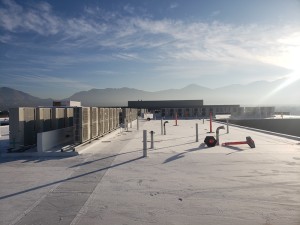As UMC, Inc. has grown, we expanded our territory outside our home state of Utah. With offices in Idaho and Colorado, we’ve become a leading provider of plumbing and HVAC services in the Intermountain West area for multi-family projects. Developing multi-family projects in these regions is no easy task. There are many factors to consider when planning a new multi-family development. Today, we wanted to highlight a factor often overlooked in the multi-family development process: the effect of altitude on HVAC system performance.
HVAC systems are particularly vulnerable to the changes in altitude we experience in the Intermountain West area. For example, at sea level, standard atmospheric pressure is 14.70 psi. But our hometown of Salt Lake City sits 4,500 feet above sea level, so a standard atmospheric pressure could range around 12.1 psi. Similarly, the higher elevations in Colorado and Idaho also change the atmospheric pressure. Lower air pressure means the air is thinner or has less air density, especially on the roofs of large buildings. Some parts of HVAC systems are vulnerable to these changes, including:
- Fans: Air density changes significantly impact fans. At higher altitudes, fans move less air mass due to lower air density, which reduces the system’s mass flow rate and affects both power draw and pressure development. When choosing fans for projects in areas with higher altitudes, we have to consider this and adjust the type of equipment we install so it will run efficiently.
- Rooftop HVAC Equipment: Rooftop units and air-cooled chillers require de-rating for high altitudes because of the lower air density and pressure. Some parts of the unit that are particularly vulnerable include the evaporator and condenser, which are impacted by the fan speed. So, when planning the HVAC design for projects requiring rooftop units, we must consider the area’s altitude and how it will affect this equipment.
- Pumping Systems: The lower atmospheric pressure at higher altitudes also reduces the efficiency of pumping systems. Systems designed for sea level pressures may not function properly at higher elevations without adjustments to maintain proper suction pressure. Our team has experience making these adjustments for the specific air pressure needs of the project’s climate.
- Motors: Like fans and pumping systems, the cooling efficiency of motors in HVAC systems decreases with lower air density, which can lead to overheating. At altitudes above 3,300 feet, HVAC motors may need higher grades of insulation and de-rating to compensate. Our team is skilled at calculating the correct level of insulation and de-rating to avoid overheating and keep HVAC system motors running efficiently.
We’ve worked on multi-family projects in the Intermountain West area for years. Our team is experienced with the climate and how the higher altitude we experience affects HVAC performance in multi-family buildings. So, if you’re planning a project in our area, choose a plumbing and HVAC firm familiar with the altitude that can make the necessary HVAC adjustments to get the best performance.







